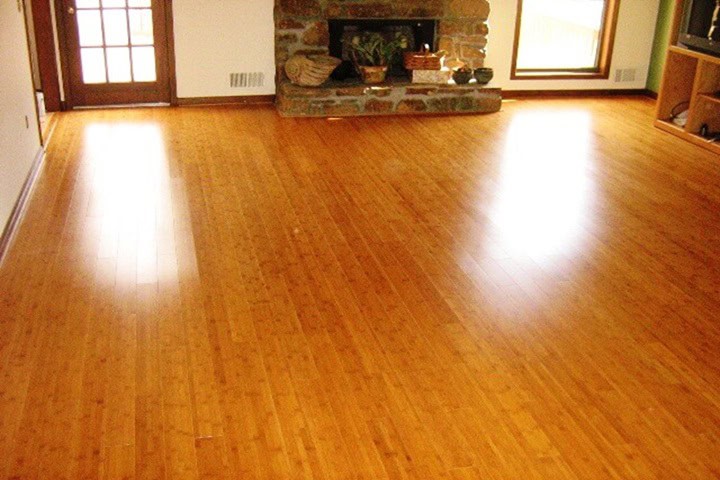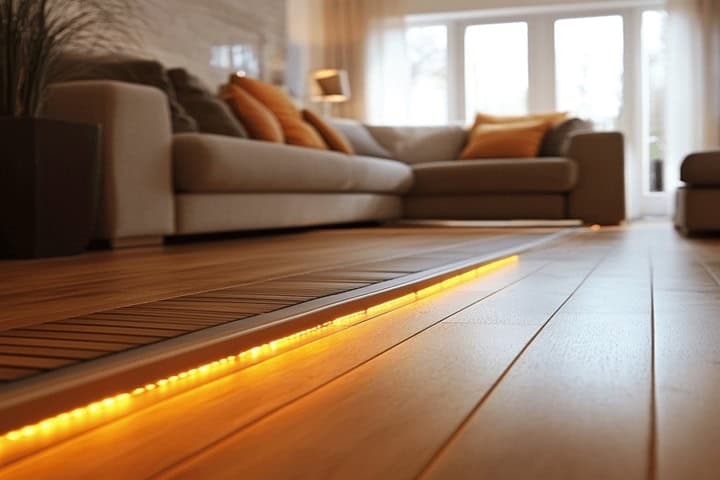Is your home ready for a sustainable yet chic makeover? Discover why bamboo flooring is a superb match for underfloor heating systems.
Bamboo flooring is a unique revelation within the floor industry, and many homeowners are beginning to be aware of its benefits for their homes. But, for those with underfloor heating already in their homes, and are looking to switch up their flooring types, may be unsure whether bamboo flooring is suitable for underfloor heating. Therefore, in this article, we will discuss the integration of bamboo flooring for underfloor heating, with what advantages it can bring to UK homes, from environmental sustainability, to its unmatched durability and aesthetic appeal. By the end of this article, the only question you will have left is why you didn’t consider this option sooner?!
Key points:
- Understand the unique properties that make bamboo flooring for underfloor heating an ideal option.
- Explore the different types of bamboo flooring for underfloor heating: vertically laminated, horizontally laminated, and strand woven.
- Learn about the durability and aesthetic options of bamboo flooring.
- Gain insights on how to prepare and maintain bamboo flooring over radiant floor heating.
- Discover the environmental benefits of choosing bamboo as the best flooring for underfloor heating.
Understanding Bamboo Flooring for Underfloor Heating
Bamboo flooring is a unique and innovative choice for homeowners, especially those considering underfloor heating.
Despite its hardwood-like appearance, bamboo actually originates from the grass family. It includes remarkable strength and rapid growth, typically reaching maturity for harvesting every four to five years.
The primary source for the bamboo used in flooring is Moso bamboo, cultivated mainly in China. This resilient plant can shoot up to 90 feet within a few months after sprouting, making it an exceptionally renewable resource.
Types of Bamboo Flooring for Underfloor Heating

Since bamboo flooring is an incredibly versatile product during its construction stage, this makes it suitable for various styles and finishes that cater to different aesthetic preferences and functional needs, including:
- Vertically Laminated: Created by bonding bamboo strips vertically, this type yields a linear, uniform appearance.
- Horizontally Laminated: This type involves bonding bamboo strips horizontally, showcasing the natural nodes of the bamboo for a more distinct pattern.
- Strand Woven: The most durable option, strand woven bamboo flooring is made from bamboo fibres fused with resin under high pressure and heat. It’s known for its density and hardness, making it suitable for high-traffic areas.
These diverse constructions make bamboo flooring adaptable and suitable for a variety of interior designs, from modern to traditional.
Benefits of Bamboo Flooring
If you are unsure about the benefits of bamboo flooring, here is what you should know:
Availability
Bamboo flooring is available to purchase from multiple stores, and is also sustainable.
Its primary source regions in Southern China and Taiwan produce an abundant supply due to the fast-growing nature of the Moso bamboo, which thrives even in less-than-ideal soil conditions without the need for excessive water or fertilisers.
Durability
Bamboo floors are remarkably durable, often lasting up to 50 years with proper care.
As bamboo matures, it acquires the hardness of traditional hardwoods but maintains greater stability, making it an excellent choice for both residential and commercial applications, making it suitable – not just for homes – but for offices, stores, and other high activity institutions.
Aesthetic
Bamboo flooring offers a range of aesthetic options.
Its natural state provides a warm, honey-gold hue, while processes like carbonisation can darken the strands to achieve richer, deeper tones.
Additionally, bamboo can be stained to match contemporary interior palettes, making it a versatile choice for design-conscious homeowners.
Sustainability
Bamboo is an eco-friendly choice for flooring due to its ability to regenerate quickly without needing replanting. The bamboo plants propagate from their rhizomes, allowing continuous harvesting without depletion, contributing to its status as one of the most sustainable building materials available.
Bamboo Flooring with Underfloor Heating

Now that you are aware of the overall benefits of bamboo flooring, you now need to understand how bamboo flooring works with underfloor heating in order to produce a variable and controllable amount of heat in UK homes:
Compatibility
Bamboo flooring for underfloor heating is an excellent option because it effectively withstands the typical temperature ranges of radiant heating systems, which are usually maintained between 75 – 80 degrees (Fahrenheit).
This compatibility ensures that bamboo flooring remains stable and does not undergo the expansion and contraction that can affect other wood floors.
Resistance
Unlike traditional hardwoods, which can be susceptible to warping and cupping due to moisture variations, bamboo’s natural properties make it resistant to moisture changes. This makes bamboo flooring suitable for underfloor heating, as it minimises the risk associated with humidity fluctuations commonly found in other wood products.
Is Bamboo Flooring Suitable for Underfloor Heating?
Considering its durability, aesthetic flexibility, and environmental benefits, bamboo flooring is not only suitable but also beneficial for homes with underfloor heating systems. It aligns with the needs of sustainable, efficient heating solutions without compromising on style or structural integrity, meaning it can work just as well alongside wet or electric underfloor heating.
Subfloor Preparation
Before adding bamboo flooring with underfloor heating to your home, it is crucial to prepare the subfloor precisely.
For example, the base must be flat, level, dry, and clean to ensure the best installation and performance. Any moisture issues should be resolved beforehand, as bamboo, while resilient, requires a stable environment to prevent warping or other damages.
It’s best to do this in new build homes rather than contemporary homes to avoid overall damage.
Installation
If you already have underfloor heating installed in your home and you are looking to switch up your flooring options, you should turn off the underfloor heating before laying down the bamboo flooring. This precaution prevents any premature expansion or contraction of the bamboo due to heat exposure during installation.
It’s recommended to keep the heating system off until the bamboo is securely installed and acclimated to the room’s natural temperature.
Heat Distribution
To ensure the best performance, bamboo flooring needs an even heat distribution. This ensures the bamboo expands and contracts uniformly across the entire surface, maintaining stability and integrity.
If part of a room has underfloor heating while another part does not, it could lead to uneven expansion, potential structural issues, and other common underfloor heating problems.
Temperature Control
Once installed, it’s critical to monitor and control the temperature of the underfloor heating system. This can be done using our heating thermostats.
The surface temperature of bamboo flooring should not exceed 26°C to prevent any heat damage or excessive expansion. Maintaining a consistent temperature also helps in prolonging the life of your flooring.
Tips for Installing Bamboo Flooring for Underfloor Heating
Be sure to follow these tips below to ensure the best performance and quality of both your bamboo flooring and underfloor heating systems:
- Choosing Compatible Materials: Ensure that the specific type of bamboo flooring is suitable for underfloor heating. Not all bamboo floors are necessarily the same; some might be too thick or not designed to handle the thermal conductivity required by underfloor heating systems.
- Using Proper Underlay: If you opt to float your bamboo flooring, choose an underlay specifically designed for thermal compatibility. This underlay should efficiently transfer heat from the system to the flooring without creating hot spots or insulation barriers that could affect heating efficiency. Choose from these adhesives and self levellers to keep your underfloor heating and flooring secure.
- Avoiding Physical Damage: During installation, avoid using nails or screws that might penetrate the heating system beneath the bamboo flooring. Such accidents can cause significant damage to the heating elements and lead to expensive repairs.
- Expansion Gaps: Remember to leave an expansion gap of at least 10mm around the edges of the installation area. This space will allow for any natural expansion that occurs with changes in temperature and humidity, preventing the bamboo from buckling.
- Reading The Instructions: Always follow the manufacturer’s guidelines included with your bamboo flooring. These instructions provide crucial details specific to the product that, if ignored, could void warranties or lead to improper installation.
Choose Underfloor Heating Trade Supplies To Heat Your Home
At Underfloor Heating Trade Supplies, we prioritise our customers’ budget with efficient heating systems, ensuring that we provide the best underfloor heating options in the UK to work alongside different flooring types. Our products are not only suitable for bamboo flooring, but also timber floors, concrete floors, porcelain or ceramic tiles, and more.
For further information, view our flooring articles via our blog, and if you are still unsure on your flooring, do not hesitate to contact us today for any enquiries.
Integrating Bamboo Flooring with Your Home’s Heating Needs
In conclusion, it is evident that bamboo flooring is an excellent choice for homes with underfloor heating, offering both aesthetic and functional benefits. Its natural properties make it well-suited for efficient heat distribution, contributing to a comfortable and sustainable home environment. By choosing bamboo, homeowners can enjoy a flooring option that not only looks great but also improves the functionality of their underfloor heating system.
For more tips on flooring sustainability, check out these sustainable trends for 2024 to look out for.
FAQs
How does underfloor heating affect bamboo flooring?
Underfloor heating can cause minor expansion and contraction of bamboo flooring due to temperature changes. Engineered bamboo flooring, designed for stability, helps minimise these effects. It is crucial to maintain consistent heating levels to avoid sudden changes that could damage the flooring.
What precautions should I take when installing bamboo flooring with underfloor heating?
Before installation, ensure the subfloor is dry, clean, and level. The underfloor heating system should be gradually heated before the bamboo flooring is installed to acclimatise it. Use an adhesive that is compatible with both the flooring and the heating system, and follow the manufacturer’s guidelines on maximum surface temperatures and heating cycles.
Sources
Moso Bamboo. (n.d.) Home. [online] Available at: https://www.moso-bamboo-outdoor.com/ [accessed 19/08/24]
Barns, J., (2024) The Future of Sustainable Flooring: Trends To Look Out for in 2024. Intelligent Living. [online] Available at: https://www.intelligentliving.co/sustainable-flooring-trends-2024/ [accessed 19/08/24]
